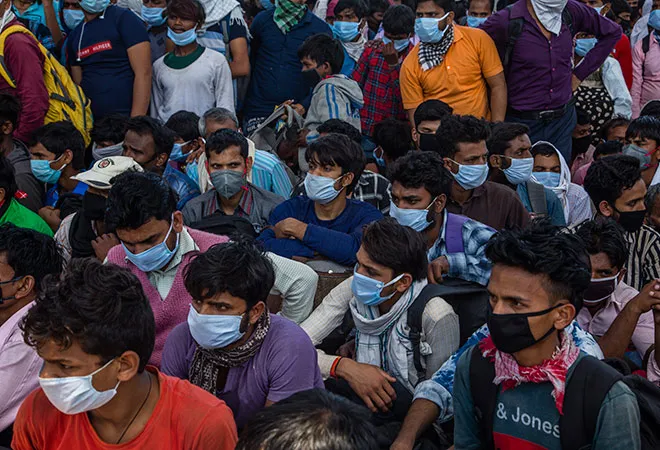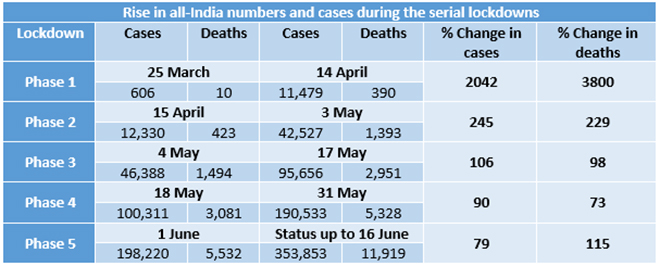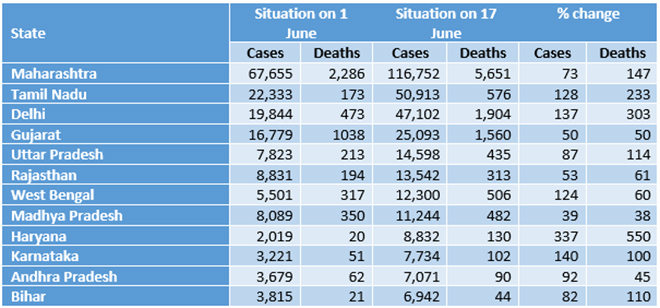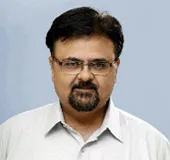-
CENTRES
Progammes & Centres
Location
India’s balancing act for safeguarding lives and livelihoods with generous lockdown relaxations is set to see a spike in cases and death toll before the curve truly flattens out

The galloping number of COVID-19 cases in India following the nation-wide lockdown relaxation from 1 June suggests that the centre and state governments, have unwittingly braced themselves up for the population to develop ‘herd immunity’ to the novel coronavirus. After nearly two-and-a-half months of strict, curfew-like restrictions—acknowledged as one of the strongest contagion containment measures in the world—imposed from 24 March and extended over four phases, the Union Ministry of Home Affairs announced Lockdown 5.0 from 1 June 2020. Enforced up to 30 June, however, phase 5 of the lockdown was more in the nature of ‘unlocking’ and ‘reopening’. On the same day, Maharashtra, the state worst affected by the virus, also began its ‘Mission Begin Again’ and announced major relaxations in all areas except the worst-hit containment zones.
The early imposition of the lockdown and mass awareness about preventive measures, such as social distancing and personal hygiene, ensured that India was successful in avoiding an explosion of infections after the first case was detected in late January. Given the size of the population, India has done extremely well in not just containing the spread, but also in keeping the case fatality rate (CFR) at a much lower level compared to the rest of the world.
On 16 June, as the country’s confirmed case count stood at 353,853, it accounted for nearly 12,000 deaths, marking a CFR of 3.4 percent—second only to the US, which had a CFR of 2.98 when it registered 10,000 deaths. However, reports based on data collated from global COVID-19 trackers and India’s health ministry suggest that while most countries have considerably brought down the number of deaths on a rolling seven-day average after hitting 10,000 fatalities, India has witnessed a fierce spike in the daily COVID-19 toll. Furthermore, the manner in which cities have reported life to be swiftly going back to the normal pre-lockdown ways since 1 June, is also likely to reverse the decreasing trend in the growth of cases.
Conflicting estimates about the time when the outbreak is likely to achieve its peak in India are also adding to the confusion regarding the preparedness and capacity of the country’s public health machinery to tackle the rising number of cases in the coming months. For example, while doctors of reputed medical institutions have predicted the peak to come anytime between mid-July to August, a study first attributed to the Indian Council for Medical Research (ICMR) predicts the contagion to peak in the country only by mid-November. The study proclaimed that the country will face shortage of isolation beds, ICUs and ventilators. The ICMR was however quick to distance itself from the same. In a tweet, the Council termed the study as “misleading” and said that the paper was a “non-peer review modelling, not carried out by ICMR and does not reflect the official position of ICMR”.
 Source: Hindustan Times e-paper editions
Source: Hindustan Times e-paper editions
While the general trend during the lockdown shows a decline in the growth of cases, the period of 29 days from the beginning of phase 4 up to mid-way in the ongoing lockdown phase 5 has recorded a significant increase of the same. From 18 May to 16 June, the number of cases has increased by 253 percent and the death count has jumped by 287 percent.
Furthermore, the 10-most affected states have on average registered a 112 percent increase in the number of cases and a 126 percent rise in the number of deaths from 1 June to 17 June. As of 17 June, of the total all-India count of 367,117 confirmed cases, these worst affected states collectively contributed 88 percent. Of the 12,259 total deaths recorded in the country, 96 percent deaths have happened only in these 10-most affected states.
 Source: https://www.mygov.in/corona-data/covid19-statewise-status/
Source: https://www.mygov.in/corona-data/covid19-statewise-status/
Faced with the Hobson’s choice of balancing out lives and livelihoods, the government—in spite of the current situation and precarious short-term scenario—is determined to push the wheels of the economy out of the deep rut created by the serial lockdowns. The country’s political leadership, too, has expressed hope that gradual reopening and creating a sense of normalcy will lead to the sprouting of “green shoots” of an economic revival. While pent up demand is bound to lead to an increase in consumption and spending in the initial period of the ‘opening up’, whether such trends will continue over the next couple of months—especially with the expected explosion in infections—is a question that has no definite answer. One needs to also factor in the spread of monsoon-related communicable diseases, which will add to the number of co-morbidities that the poor are likely to carry over the next three months.
"Faced with the Hobson’s choice of balancing out lives and livelihoods, the government—in spite of the current situation and precarious short-term scenario—is determined to push the wheels of the economy out of the deep rut created by the serial lockdowns."
Against this backdrop, the country is unintentionally moving towards a situation where the population, especially the poor and underprivileged, are hoped to develop herd immunity to the pandemic. According to an article published by the Johns Hopkins Bloomberg School of Public Health, “when most of a population is immune to an infectious disease, this provides indirect protection—or herd immunity (also called herd protection)—to those who are not immune to the disease”. Stating that it would take up to 70 to 90 percent of the population to get infected before herd immunity is established against the novel coronavirus, the article mentions infectious diseases such as measles, mumps, polio, and chickenpox “that were once very common but are now rare in the US because vaccines helped to establish herd immunity”. With no guaranteed COVID-19 vaccine becoming available anytime soon, India’s balancing act to revive the economy from the lockdown shocks while also keeping the infection under control carries a risk that the government has opted to hedge its bet on.
The views expressed above belong to the author(s). ORF research and analyses now available on Telegram! Click here to access our curated content — blogs, longforms and interviews.

Dhaval is Senior Fellow and Vice President at Observer Research Foundation, Mumbai. His spectrum of work covers diverse topics ranging from urban renewal to international ...
Read More +